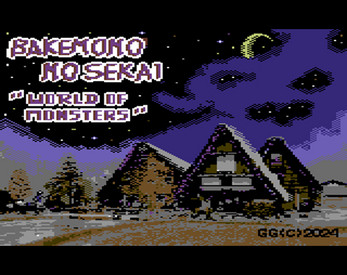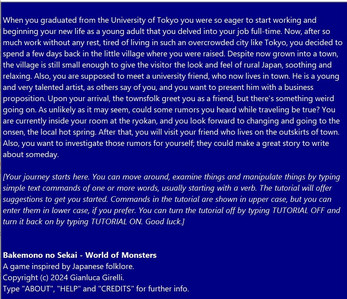
World of Monsters (TALP)
When you graduated from the University of Tokyo you were so eager to start working and beginning your new life as a young adult that you delved into your job full-time. Now, after so much work without any rest, tired of living in such an overcrowded city like Tokyo, you decided to spend a few days back in the little village where you were raised. Despite now growing into a town, the village is still small enough to give the visitor the look and feel of rural Japan, soothing and relaxing. Also, you are supposed to meet a university friend, who now lives in town. He is a young and very talented artist, as others say of you, and you want to present him with a business proposition. Upon your arrival, the townsfolk greet you as a friend, but there's something weird going on. As unlikely as it may seem, could some rumors you heard while traveling be true? You are currently inside your room at the ryokan, and you look forward to changing and going to the onsen, the local hot spring. After that, you will visit your friend who lives on the outskirts of town. Also, you want to investigate those rumors for yourself; they could make a great story to write about someday.
Instructions
This is a traditional text adventure that was written for Text Adventure Literacy Jam 2024, 1 March to 30 April 2024. See the jam page for the competition rules.
A text adventure is a form of computer game that presents you with a story. You take on the role of the main character in the story and control that character's actions. The story has a goal and you will need to solve puzzles to achieve that goal. The computer tells you where you are, what you can see and what's happening around you. You can then move around, examine the things you find and manipulate those things by telling the computer what to do using simple English commands.
Commands consist of a verb phrase, optionally followed by a noun phrase. Most commands can be abbreviated to a verb followed by a noun. For example, OPEN THE FRONT DOOR can be abbreviated to OPEN DOOR.
If the verb is followed by a preposition, this may alter its meaning. For example, GET BED will attempt to pick up the bed, but GET ON BED will attempt to climb onto it.
In some cases, the verb phrase and first noun phrase may be followed by a second noun phrase. The two noun phrases are usually separated by a preposition. For example, HIT MAN will attempt to hit the man with your hands (as you didn't specify a second noun phrase), but HIT MAN WITH ROCK will attempt to hit the man with the rock. If you only use a verb and a noun, the game will generally tell you if it needs an extra phrase or implicitly try to deduce what is needed for the second phrase.
Don't panic! It's not as complicated as it sounds. Just use simple English sentences starting with a verb and it will all feel quite natural.
Movement
To move around, use commands like GO NORTH and GO SOUTH. You can move in any of the four cardinal compass directions. To save typing, movement commands can be abbreviated to N, S, E and W. You can sometimes use other movement commands such as IN, OUT, ENTER, EXIT, GET IN or GET OUT. These will be reasonably obvious when the time comes.
Examining things
Make sure you EXAMINE everything you come across, even insignificant things like scenery and objects mentioned in room descriptions, as subtle hints and clues are scattered everywhere. To save typing, EXAMINE can be abbreviated to X. For example, EXAMINE LOBBY can be abbreviated to X LOBBY.
You can also try your other senses when it seems appropriate, e.g. SMELL, TOUCH or LISTEN. Unlike EXAMINE, these actions aren't necessary to solve any puzzles but may prove useful later in the game.
Manipulating objects
Apart from examining things, most of your time will be spent manipulating objects. Use commands like GET or TAKE to pick up an object, e.g. GET NEWSPAPER. Use commands like DROP or DISCARD to drop an object, e.g. DROP NEWSPAPER.
To see what you're currently carrying and wearing, use INVENTORY (or I). As you're not a pack horse, you can only carry ten items at a time.
There are many other verbs that can be used to manipulate objects. These will be fairly obvious when the time comes. Common verbs include OPEN, CLOSE, EAT, DRINK, READ and so on. Use PUT, PLACE or INSERT to put objects into containers or on supporters, e.g. PUT NOTEPAD IN POCKET.
Communicating with characters
You will encounter a lot of characters in this game. When you first meet new characters, in addition to examining them, you should try talking to them, e.g. TALK TO MANAGER. To get further information from them, try asking them about something relevant, e.g. ASK MANAGER ABOUT MYSTERY. This game is primarily about gathering information, so you will need to ask lots of characters about lots of things.
Advanced features
You can use IT or THEM to refer to the noun used in the previous command, e.g. EXAMINE BAG, OPEN IT (for a singular object) or TAKE BEANS FROM BAG, DROP THEM (for plural objects). You can also use HIM and HER to refer to male and female characters used in the previous command, e.g. ASK MANAGER ABOUT BOOK, ASK HIM ABOUT BOOK, or EXAMINE MIKO, TALK TO HER.
You can refer to multiple objects by separating the objects with AND, e.g. GET NEWSPAPER AND KEY. Using IT and THEM in the next command will only refer to the last of those objects, e.g. EXAMINE IT will refer to the key.
You can use ALL to refer to all the appropriate objects with GET and DROP, e.g. GET ALL to get everything in the current location, GET ALL FROM TABLE to get everything on the table, DROP ALL to drop everything you're holding, but not wearing.
When using ALL, you can use EXCEPT or BUT to exclude some objects, e.g. DROP ALL EXCEPT STOOL.
Finally, you can enter multiple commands on the same line by separating them with a period, e.g. EXAMINE FUSUMA. OPEN IT.
Scoring
There is no score in this game. Your objective is to... Well, that's for you to find out.
Other commands
Use LOOK (or L) to refresh the display.
Use VERSION to get the game version. Use ABOUT or INFO to get background information and credits for the game. Use CREDITS to get the credits only.
Use SAVE to save your progress. Use RESTORE to restore a saved game.
Use UNDO to undo the last move. This is handy if you change your mind or make a mistake. You shouldn't be able to get killed or get into an unwinnable situation in this game. (UNDO is not available with the z3 version of the game.)
Use AGAIN (or G) to repeat the last command.
Use WAIT (or Z) to do nothing apart from passing the time.
Use HELP to get a brief reminder of how to play the game or HINT to get a context-sensitive hint related to the current location. (This will be added after beta testing.)
Use RESTART to restart the game from the beginning. Use QUIT (or Q) to quit without restarting. (Don't use QUIT with the online version of the game, as the game will appear to be locked up. If this happens, press the Back button in your browser.)
Most importantly, have fun and enjoy the game.
Keyboard shortcuts
Some interpreters have keyboard shortcuts. If you are using an interpreter on a computer with a conventional keyboard, most will allow you to press the up and down arrow keys to cycle through your past commands. This is handy if you want to repeat the previous command or correct a typo.
Playing the game
There are many ways to play the game.
- Click the Run game button (above) to play the game in a browser.
- Download the z5 file and play the game using a z-code interpreter (see below). This will allow you to play on Windows, Mac, Linux, iOS, Android, ZX Spectrum Next and on Amiga OS 4.1 (see the "Install Instructions" further down).
- Download the appropriate disk image to play using an emulator (VICE, C64Forever etc.) or to play on real hardware.
Please refer to the "Install Instructions" for additional details.
Finding a Z-code interpreter
There are a variety of z-code interpreters for all the major platforms, as well as many minor and retro platforms. There are far too many to list here. The best source of downloads is probably the Interactive Fiction Archive. Navigate to infocom/interpreters for z-code interpreters and interpreters-multi for interpreters that interpret both z-code games and other formats.
Common z-code interpreters
Android: I recommend Hunky Punk from Google Play. (There are others, as well.)
iOS: I recommend Frotz from the Apple App Store. (There are others, as well.)
Linux: See the links above.
Mac: See the links above.
Windows: I recommend Windows Frotz from the Infocom/interpreters link above. (There are others, as well.)
ZX Spectrum Next: the interpreter is embedded in the system software. See below.
Amiga OS 4.1: you can find the Amiga implementation of Frotz HERE.
Credits
Inform 6 compiler, language and library originally written by Graham Nelson and now maintained by David Griffith, David Kinder, Andrew Plotkin et al.
PunyInform library written by Johan Berntsson and Fredrik Ramsberg based on the Inform 6 library.
Concept, game design and coding by Gianluca Girelli.
Testing by Garry Francis, Ruggero Simoncelli.
Special thanks to Mr. Masaki Mori for his insights on yokai and rural Japan.
Cover image is (C) Gianluca Girelli, created by editing a picture I took while visiting the village of Shirakawa-go in Japan.
Tiled background image by Shigeru Mizuki, taken from the internet.
Page layout and text taken from Garry Francis's pages, after prior permission.
| Status | Released |
| Platforms | HTML5 |
| Rating | Rated 5.0 out of 5 stars (1 total ratings) |
| Author | Gianluca Girelli |
| Genre | Interactive Fiction, Adventure |
| Tags | Fairy Tale, japanese-themed, Monsters, Text based, yokai |
Download
Development log
- Bakemono no Sekai updateAug 24, 2025
- Post-jam releasesAug 19, 2024



Comments
Log in with itch.io to leave a comment.
Grazie, Zeno.
Accurate descriptions and well-documented setting. I appreciate meeting not-so-known folklore creatures!👹